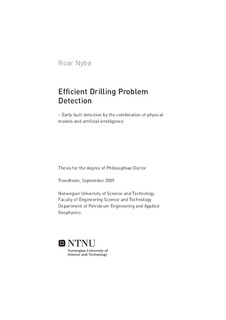Efficient Drilling Problem Detection: Early fault detection by the combination of physical models and artificial intelligence
Doctoral thesis
Permanent lenke
http://hdl.handle.net/11250/239305Utgivelsesdato
2009Metadata
Vis full innførselSamlinger
Sammendrag
The drilling of an oil or gas well is an expensive undertaking. Hence, it is not surprising that mistakes and accidents during drilling incur a high cost. Accidents could result in the loss of expensive equipment and subsequent delays setting back the operation for days or weeks and thus running up large bills on rig-time and personnel hours. Some types of accidents also pose a risk to the personnel or the environment. In this dissertation we study alarm systems which could give the driller an early warning of upcoming problems, and thus provide time to avoid these accidents. We explore alarm systems which combine advanced physical models of the well and drilling process with artificial intelligence and time series analysis. Finally, we determine the advantages as well as the challenges of this approach.
It is our hope that this dissertation is accessible to both practitioners in machine learning and control engineering, as well as to petroleum engineers with a passing familiarity with machine learning. Hence this dissertation starts with a quick introduction to drilling problems and some terms from time series analysis and machine learning. We then briefly describe the theory of observer-based fault detection and isolation. Theories of supervisory control systems are also introduced, as these concern both the choice of algorithms and how AI-based alarm systems integrate with the rest of the operation. From chapter 6 and onward, the challenges to fault detection in drilling are discussed. We focus on clarifying what restrictions the available training data put on our choice of machine learning methods. In chapter 8 and 9, we propose ways to combine machine learning and observer-based fault detection. Experimental results are presented in chapter 10, before we end with concluding remarks in chapter 11.
Our main conclusion, reflected in our experimental results, is that physical models and artificial intelligence can be combined to produce hybrid alarm systems that are better than what we could have achieved using these approaches separately. When using artificial intelligence we treat fault detection in drilling as a machine learning problem. In the course of our work we find that this problem domain differs in important respects from textbook examples of machine learning problems. Determining the distinctive characteristics of this problem domain is crucial in designing the alarm system. Drawing on examples from different fields we determine these characteristics and propose novel alarm system architectures that build on recent developments in machine learning.
